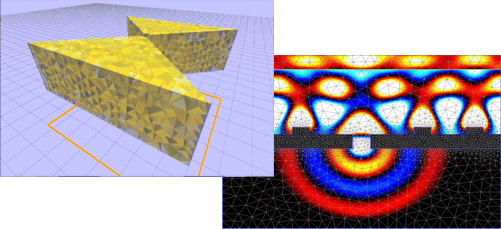OmniSimOmni-directional photonic simulations |
    |
PlasmonicsFDTD, FETD and FEFD simulations with OmniSim softwarePlasmonics, which is the study of interaction between light and metal, is a very active field of research, owing to the potential offered by the ability to confine light beyond the limits of diffraction. Many properties of plasmonic structures can be derived directly from Maxwell's equations, and methods such as FDTD and finite-element algorithms are widely used for designing and optimising plasmonic nano-structures. Modelling tools for plasmonicsFDTD is probably the most widely used method for characterising plasmonics, and it is very effective at providing results quickly with a reasonable accuracy. The downfall of FDTD is when you need to refine the resolution - a 10x refinement in grid spacing will typically result in a 1,000x increase in memory use and a 10,000x increase in calculation time! This can be a big problem when modelling surface plasmons in metallic structures, where very fine resolution is routinely needed to obtain accurate results. This is where our innovative FETD (Finite-Element Time-Domain) simulator steps in, allowing you to obtain highly accurate results in a fraction of the time needed for FDTD. FDTD and FETD are two truly complementary methods, which can be used to model structures of similar size and complexity. With OmniSim, you can choose the most efficient calculation method for your structure, and you can also model your design with two independent engines - ideal to check the accuracy of your simulations. Note that you can also model plasmonic waveguides with FIMMWAVE and FIMMPROP. Advanced plasmonic modelling: nonlinearities and grapheneIn addition, you can model nonlinear (chi2 and chi3) properties of metals with FDTD and FETD; the FETD engine in particular will allow you to model surface nonlinearities (chi2). The FETD engine also features a surface material model for modelling 2D materials such as graphene, allowing you to study the interaction of plasmonic structures with graphene layers. Benefits of OmniSim for modelling plasmonicsOmniSim offers you many ways to model plasmonic structures:
Having a number of different methods is very useful as it allows you to choose the most efficient method for your specific design, and also to run the calculation with multiple methods to check the accuracy of your calculations. In order to account for dispersive properties of metals and dielectric materials, our time-domain engines FETD and FDTD support a variety of material models include Drude, Drude-Lorentz, Lorentz and Debye; frequency domain tools such as FEFD only solve one wavelength at a time and do not require to fit the material properties. ApplicationsThe examples below are a selection of OmniSim applications focusing on plasmonics. Nano-antennae (bow-tie and nut geometries) Mie Scattering from a gold cylinder
|




